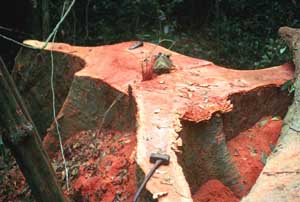|
|
 5 logging, stump DHJanzen100735.jpg high resolution
|
|
| Following my introduction to the AFTPC mill (see below), I worked my way back up the chain of operations. Here is where it begins, a newly cut rainforest tree in the very forest I was studying. This tree was not merely cut. It turned out that it had been mapped and identified the year before, and given an individual identification number (see image DHJanzen100735.jpg above). A list of the trees large enough to harvest in its square mile had been submitted, then, to the Nigerian Forest Department. The Forest Department foresters had then indicated that this particular tree, along with perhaps another 19 trees in this square mile, were to be charged to the AFTPC. It was their decision whether to cut and harvest them, but they would be charged irrespective. The 20 trees were chosen such that they left 20 holes in the forest canopy, and each tree was in reproductive middle age. And then the tree was felled exactly where it would not hit or damage other large trees in the process of falling (and forest inspectors checked each tree cut, and fined the AFTPC if other trees had been hit). While this cutting is going on in one square mile, in an adjacent square mile the trees are being mapped, and in three other adjacent square miles, the follow-up process (see below) is in motion. | ||
back to lecture slides
or skip to: